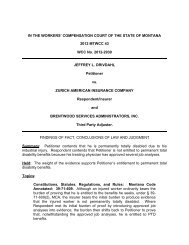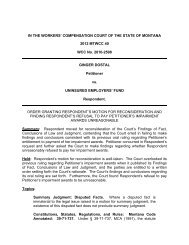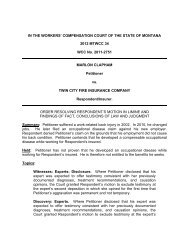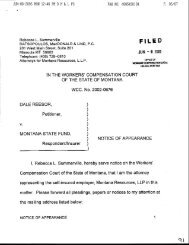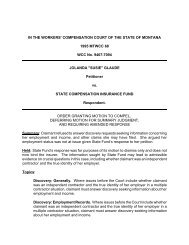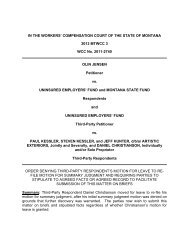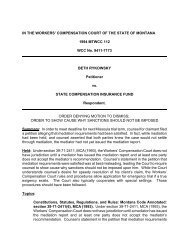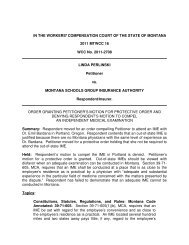2010 MTWCC 16 - Workers' Compensation Court
2010 MTWCC 16 - Workers' Compensation Court
2010 MTWCC 16 - Workers' Compensation Court
Create successful ePaper yourself
Turn your PDF publications into a flip-book with our unique Google optimized e-Paper software.
wanted. The mechanics brought their own clientele which went with them when theyleft. The mechanics had keys to the building. Although Moothart theorized thatHallquist could control the mechanics’ access by changing the locks to the building, itappears that any of the mechanics could have changed the locks if they chose to do so.69 Although the mechanics almost always ordered parts through P & MTransmission’s business accounts, they were not required to do so, and the partsaccounts were set up on a cash-only basis so that anyone – even mechanics who didnot work at 810 East Iron Street – could and did order parts using these accounts.Hallquist testified that any mechanic at the shop could accept payment from customersand that any amounts owing would be settled whenever the books were balanced. InRichter’s case, Hallquist testified that Richter inexplicably left in the middle of the dayand never returned. Although Hallquist attempted to contact Richter to find out whathad happened to him, there is no evidence that Hallquist attempted to control Richter bydemanding that he return to work at the shop, or even by offering Richter’s space toanother mechanic until it became clear that Richter had no intention of returning. Fromthe evidence presented, I conclude that not only did Hallquist not choose to exercisecontrol over the mechanics, but that he had no right to do so.70 Method of Payment: When payment is by quantity or percentage, the method ofpayment test largely cancels itself out and becomes neutral. 124 Since I have found thatboth Blackwood and Richter were paid by percentage, this factor becomes neutral in mydetermination of whether they were employees of P & M Transmission.71 Furnishing of Equipment: An employment relationship almost invariably existswhere the purported employer has furnished valuable equipment. 125 In the presentcase, all the mechanics who worked in the shop, including Blackwood and Richter,personally owned extensive collections of personal hand tools. Since no mechanicowned every possible tool, the mechanics freely shared their hand tools with eachother. The lifts and air compressor were fixtures of the building and therefore owned byDeBarathy.72 Hallquist testified that the mechanics used a parts washer which he ownspersonally, and a spray wash cabinet which P & M Transmission owns. Given thatHallquist has worked in the shop at 810 East Iron Street the longest out of all themechanics at issue in the present case, it certainly makes sense that the shop wouldcontain some larger equipment owned by Hallquist. The testimony in this caseindicates that hand tools, equipment, and the building fixtures were freely shared and124 Walling v. Hardy Constr., 247 Mont. 441, 449, 807 P.2d 1335, 1339 (1991) (citing 1C A. Larson,Workmen’s <strong>Compensation</strong> Law § 44.33(b), at 8-106 (1990)).125 American Agrijusters, 33. (Citation omitted.)Findings of Fact, Conclusions of Law and Judgment- 22


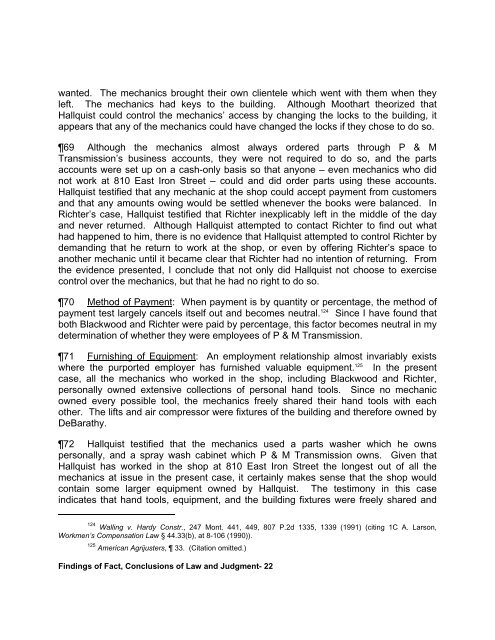
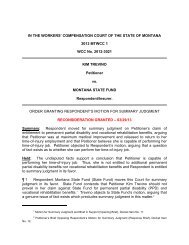
![Bustell v. AIG Claims Service, Inc. [05/03/05] 2005 MTWCC 23](https://img.yumpu.com/49777654/1/190x245/bustell-v-aig-claims-service-inc-05-03-05-2005-mtwcc-23.jpg?quality=85)
![Vallance v. MCCF [07/05/06] 2006 MTWCC 26 - Workers ...](https://img.yumpu.com/48724322/1/190x245/vallance-v-mccf-07-05-06-2006-mtwcc-26-workers-.jpg?quality=85)
